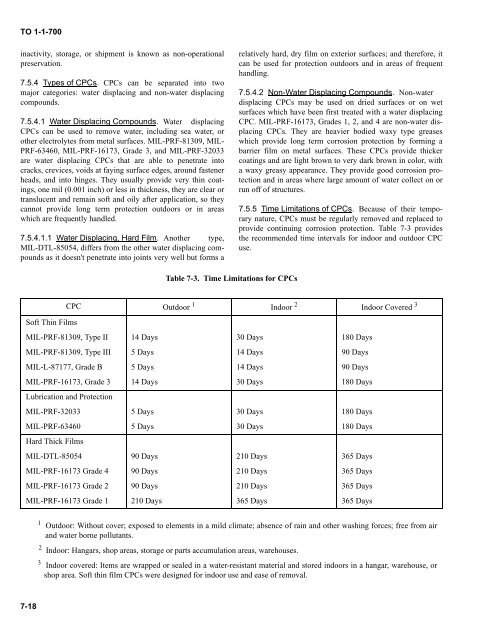TO 1-1-700 - Robins Air Force Base
TO 1-1-700 - Robins Air Force Base
TO 1-1-700 - Robins Air Force Base
Create successful ePaper yourself
Turn your PDF publications into a flip-book with our unique Google optimized e-Paper software.
<strong>TO</strong> 1-1-<strong>700</strong><br />
inactivity, storage, or shipment is known as non-operational<br />
preservation.<br />
7.5.4 Types of CPCs. CPCs can be separated into two<br />
major categories: water displacing and non-water displacing<br />
compounds.<br />
7.5.4.1 Water Displacing Compounds. Water displacing<br />
CPCs can be used to remove water, including sea water, or<br />
other electrolytes from metal surfaces. MIL-PRF-81309, MIL-<br />
PRF-63460, MIL-PRF-16173, Grade 3, and MIL-PRF-32033<br />
are water displacing CPCs that are able to penetrate into<br />
cracks, crevices, voids at faying surface edges, around fastener<br />
heads, and into hinges. They usually provide very thin coatings,<br />
one mil (0.001 inch) or less in thickness, they are clear or<br />
translucent and remain soft and oily after application, so they<br />
cannot provide long term protection outdoors or in areas<br />
which are frequently handled.<br />
7.5.4.1.1 Water Displacing, Hard Film. Another type,<br />
MIL-DTL-85054, differs from the other water displacing compounds<br />
as it doesn't penetrate into joints very well but forms a<br />
relatively hard, dry film on exterior surfaces; and therefore, it<br />
can be used for protection outdoors and in areas of frequent<br />
handling.<br />
7.5.4.2 Non-Water Displacing Compounds. Non-water<br />
displacing CPCs may be used on dried surfaces or on wet<br />
surfaces which have been first treated with a water displacing<br />
CPC. MIL-PRF-16173, Grades 1, 2, and 4 are non-water displacing<br />
CPCs. They are heavier bodied waxy type greases<br />
which provide long term corrosion protection by forming a<br />
barrier film on metal surfaces. These CPCs provide thicker<br />
coatings and are light brown to very dark brown in color, with<br />
a waxy greasy appearance. They provide good corrosion protection<br />
and in areas where large amount of water collect on or<br />
run off of structures.<br />
7.5.5 Time Limitations of CPCs. Because of their temporary<br />
nature, CPCs must be regularly removed and replaced to<br />
provide continuing corrosion protection. Table 7-3 provides<br />
the recommended time intervals for indoor and outdoor CPC<br />
use.<br />
Table 7-3. Time Limitations for CPCs<br />
CPC Outdoor 1 Indoor 2 Indoor Covered 3<br />
Soft Thin Films<br />
MIL-PRF-81309, Type II 14 Days 30 Days 180 Days<br />
MIL-PRF-81309, Type III 5 Days 14 Days 90 Days<br />
MIL-L-87177, Grade B 5 Days 14 Days 90 Days<br />
MIL-PRF-16173, Grade 3 14 Days 30 Days 180 Days<br />
Lubrication and Protection<br />
MIL-PRF-32033 5 Days 30 Days 180 Days<br />
MIL-PRF-63460 5 Days 30 Days 180 Days<br />
Hard Thick Films<br />
MIL-DTL-85054 90 Days 210 Days 365 Days<br />
MIL-PRF-16173 Grade 4 90 Days 210 Days 365 Days<br />
MIL-PRF-16173 Grade 2 90 Days 210 Days 365 Days<br />
MIL-PRF-16173 Grade 1 210 Days 365 Days 365 Days<br />
1 Outdoor: Without cover; exposed to elements in a mild climate; absence of rain and other washing forces; free from air<br />
and water borne pollutants.<br />
2 Indoor: Hangars, shop areas, storage or parts accumulation areas, warehouses.<br />
3 Indoor covered: Items are wrapped or sealed in a water-resistant material and stored indoors in a hangar, warehouse, or<br />
shop area. Soft thin film CPCs were designed for indoor use and ease of removal.<br />
7-18
















